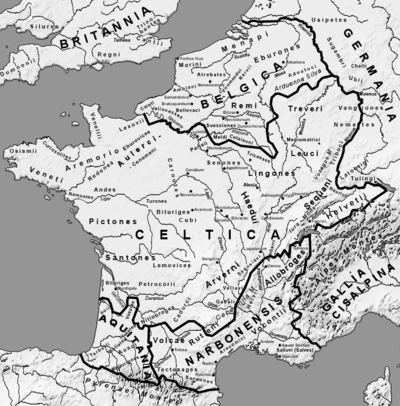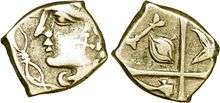Petrocorii
The Petrocorii (French: Pétrocores, Latin: Petrocorii) were a Gaulish tribe located in the present-day Dordogne region of France, between the Dordogne and Isle rivers. Their capital was Vesunna, which is today the town of Périgueux. Périgueux as well as the ancient province of Périgord take their names from this tribe.

Etymology
They are mentioned as Petrocoriis by Caesar (mid-1st c. BC),[1] as Petrokórioi (Πετροκόριοι) by Strabo (early 1st c. AD) and Ptolemy (2nd c. AD),[2][3] as Petrocori by Pliny (1st c. AD),[4] and as Petrogorii by Sidonius Apollinaris (5th c. AD).[5][6]
The Gaulish name Petrocorii means 'four armies',[7] or "four clans".[8] It stems from the Gaulish root petru- ('four') attached to corios ('army').[9] The latter derives from the Proto-Celtic root *koryo- ('troop, tribe'; compare with Middle Welsh cordd 'tribe, clan'; Middle Irish cuire), and is found in other Gaulish tribal names such as the Tri-corii or Corio-solites.[10] Petru- stems from Proto-Celtic *kʷetwóres ('four'; compare with Old Irish cetheoir, Old Welsh and Old Breton petguar).[11]
The Périgord region, attested as pagum Petrocorecum in the 7th c. AD ('pagus of the Petrocorii'; Petragoricus in 781, Peiregore in the 12th c.) is named after the Gallic tribe.[12]
Demonym


The name of the Petrocorii is sometimes used today as a demonym of Périgueux, mainly called Périgourdins.
History
According to Venceslas Kruta, "the Petrocorii lived in the region situated between the Dordogne and the Vézère."[13] In 52 BCE, they supplied around 5000 warriors to Vercingetorix, to aid him to fight the Roman legions of Julius Caesar.[14] Strabo mentions their excellence working with iron.[15]
References
- Caesar. Commentarii de Bello Gallico, 7:75:3.
- Strabo. Geōgraphiká, 4:2:2
- Ptolemy. Geōgraphikḕ Hyphḗgēsis, 2:7:9
- Pliny. Naturalis Historia, 4:109
- Sidonius Apollinaris. Epistles, 7:6:7
- Falileyev 2010, entry 3307.
- Lambert 1994, p. 35.
- Penaud, Guy (2003). Le Grand Livre de Périgueux (in French). Périgueux: La Lauze. p. 395-396. ISBN 2-912032-50-4. OCLC 52948657.
- Delamarre 2003, pp. 93, 125, 250.
- Matasović 2009, p. 218.
- Matasović 2009, p. 179.
- Nègre 1990, p. 155.
- Kruta, Venceslas (2000). Les Celtes : histoire et dictionnaire : des origines à la romanisation et au christianisme (in French). Paris: Robert Laffont. ISBN 2-221-05690-6. OCLC 45647099.
- Aubarbier, Jean-Luc; Binet, Michel; Mandon, Guy (1987). Nouveau guide du Périgord-Quercy (in French). Rennes: Ouest-France. p. 22-23. ISBN 2-85882-842-3. OCLC 19922927.
- Lachaise, Bernard (2000). Histoire du Périgord (in French). Périgueux: Fanlac. p. 94. ISBN 2-86577-216-0. OCLC 47216937.
Bibliography
- Delamarre, Xavier (2003). Dictionnaire de la langue gauloise: Une approche linguistique du vieux-celtique continental (in French). Errance. ISBN 9782877723695.CS1 maint: ref=harv (link)
- Falileyev, Alexander (2010). Dictionary of Continental Celtic Place-names: A Celtic Companion to the Barrington Atlas of the Greek and Roman World. CMCS. ISBN 978-0955718236.
- Lambert, Pierre-Yves (1994). La langue gauloise: description linguistique, commentaire d'inscriptions choisies (in French). Errance. ISBN 978-2-87772-089-2.CS1 maint: ref=harv (link)
- Matasović, Ranko (2009). Etymological Dictionary of Proto-Celtic. Brill. ISBN 9789004173361.CS1 maint: ref=harv (link)
- Nègre, Ernest (1990). Toponymie générale de la France (in French). Librairie Droz. ISBN 978-2-600-02883-7.CS1 maint: ref=harv (link)
